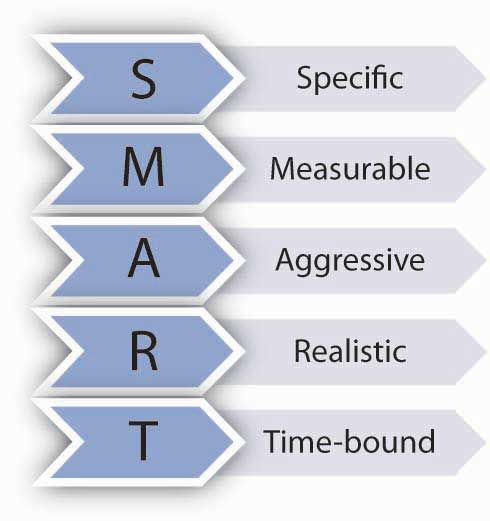6.3: Motivating Employees Through Goal Setting
- Page ID
- 4652
Learning Objectives
- Describe why goal setting motivates employees.
- Identify characteristics of a goal that make it effective.
- Identify limitations of goals.
- Understand how to tie individual goals to strategic goals.
Goal-Setting Theory
Goal-setting theory (Locke & Latham, 1990) is one of the most influential and practical theories of motivation. In fact, in a survey of organizational behavior scholars, it has been rated as the most important (out of 73 theories) (Miner, 2003). The theory has been supported in over 1,000 studies with employees ranging from blue-collar workers to research-and-development employees, and there is strong support that setting goals is related to performance improvements (Ivancevich & McMahon, 1982; Latham & Locke, 2006; Umstot, Bell, & Mitchell, 1976). According to one estimate, goal setting improves performance at least 10%–25% (Pritchard et al., 1988). Based on this evidence, thousands of companies around the world are using goal setting in some form, including Coca Cola Company, PricewaterhouseCoopers International Ltd., Nike Inc., Intel Corporation, and Microsoft Corporation, to name a few.
Setting SMART Goals
Are you motivated simply because you have set a goal? The mere presence of a goal does not motivate individuals. Think about New Year’s resolutions that you made but failed to keep. Maybe you decided that you should lose some weight but then never put a concrete plan in action. Maybe you decided that you would read more but didn’t. Why did your goal fail?

Accumulating research evidence indicates that effective goals are SMART. A SMART goal is a goal that is specific, measurable, aggressive, realistic, and time-bound.
Specific and Measurable
Effective goals are specific and measurable. For example, “increasing sales to a region by 10%” is a specific goal, whereas deciding to “delight customers” is not specific or measurable. When goals are specific, performance tends to be higher (Tubbs, 1986). Why? If goals are not specific and measurable, how would you know whether you have reached the goal? A wide distribution of performance levels could potentially be acceptable. For the same reason, “doing your best” is not an effective goal, because it is not measurable and does not give you a specific target.
Certain aspects of performance are easier to quantify. For example, it is relatively easy to set specific goals for productivity, sales, number of defects, or turnover rates. However, not everything that is easy to measure should be measured. Moreover, some of the most important elements of someone’s performance may not be easily quantifiable (such as employee or customer satisfaction). So how do you set specific and measurable goals for these soft targets? Even though some effort will be involved, metrics such as satisfaction can and should be quantified. For example, you could design a survey for employees and customers to track satisfaction ratings from year to year.
Aggressive
This may sound counterintuitive, but effective goals are difficult, not easy. Aggressive goals are also called stretch goals. According to a Hay Group study, one factor that distinguishes companies that are ranked as “Most Admired Companies” in Fortune magazine is that they set more difficult goals (Stein, 2000). People with difficult goals outperform those with easier goals (Mento, Steel, & Karren, 1987; Phillips & Gully, 1997; Tubbs, 1986; Yukl & Latham, 1978). Why? Easy goals do not provide a challenge. When goals are aggressive and require people to work harder or smarter, performance tends to be dramatically higher. Research shows that people who have a high level of self-efficacy and people who have a high need for achievement tend to set more difficult goals for themselves (Phillips & Gully, 1997).
Realistic
While goals should be difficult, they should also be based in reality. In other words, if a goal is viewed as impossible to reach, it will not have any motivational value. In fact, setting impossible goals and then punishing people for not reaching these goals is cruel and will demotivate employees.
Time-Bound
The goal should contain a statement regarding when the proposed performance level will be reached. For example, “increasing sales to a region by 10%” is not a time-bound goal, because there is no time limit. Adding a limiter such as “by December of the current fiscal year” gives employees a sense of time urgency.
Here is a sample SMART goal: Wal-Mart Stores Inc. recently set a goal to eliminate 25% of the solid waste from U.S. stores by the year 2009. This goal meets all the conditions of being SMART (as long as 25% is a difficult yet realistic goal) (Heath & Heath, 2008). Even though it seems like a simple concept, in reality many goals that are set within organizations may not be SMART. For example, Microsoft recently conducted an audit of its goal setting and performance review system and found that only about 40% of the goals were specific and measurable (Shaw, 2004).


